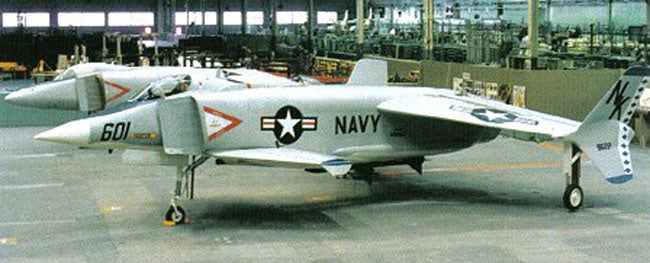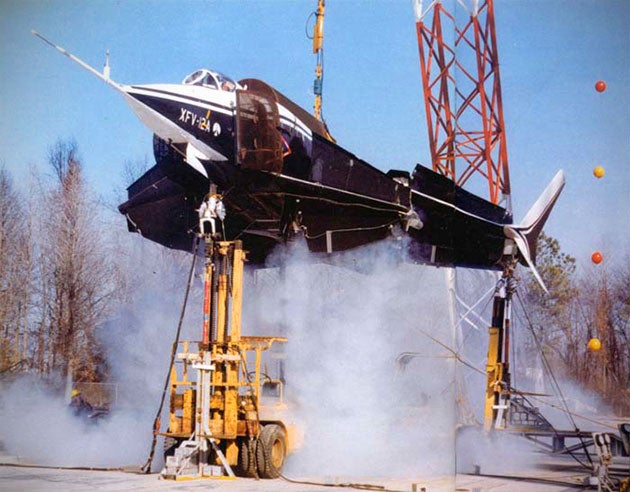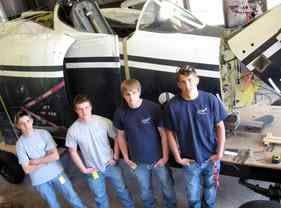 by "ttyymmnn" (ttyymmnn)
by "ttyymmnn" (ttyymmnn)
Published 06/21/2017 at 12:35
 by "ttyymmnn" (ttyymmnn)
by "ttyymmnn" (ttyymmnn)
Published 06/21/2017 at 12:35
Tags: wingspan
; planes you've (probably) never heard of
; Planelopnik
STARS: 13
From the Planes Youíve (Probably) Never Heard Of Department of Wingspan , we bring you the Rockwell XFV-12 .
!!! UNKNOWN CONTENT TYPE !!!

As the Cold War raged on in the late 1960s, the United States military was planning for the possibility of a full-scale hot war with the Soviet Union. They believed that, just as it had during WWII, the US would need to transport the majority of its materiel in large ocean-going convoys, since any war would most likely take place in Europe. Soviet submarines posed the greatest danger to these convoys, so the US Navy envisioned a fleet of smaller escort carriers called Sea Control Ships (SCS) to provide protection. Significantly simpler and less expensive than a massive nuclear super carrier, the SCS would carry a complement of sub-hunting helicopters along with a small contingent of jet fighters to protect the convoy from the prying eyes of Soviet long-range aircraft that could direct the enemy subs to their targets. The obvious choice for a fighter to fly from an SCS was the Hawker Siddeley AV-8A Harrier , then being flown by the US Marine Corps. While a capable aircraft in its own right, the Navy wanted much more speed than the subsonic Harrier could offer. They wanted something that could not only take off vertically but also fly in excess of Mach 2.

In 1972, the Navy announced its interest in developing a new VTOL fighter that would have the speed and armament of the McDonnell Douglas F-4 Phantom II . Rockwell responded with the XFV-12, an aircraft built on the cheap and cobbled together from existing aircraft parts. The cockpit and landing gear came from the Douglas A-4 Skyhawk , and the air intake boxes were taken from the F-4. The single Pratt & Whitney F100 engine was the same used on the Grumman F-14 Tomcat , though it was heavily modified for the VTOL requirements. For vertical takeoff, the rear output of the engine was closed and thrust was redirected through vents in the thrust augmented wings. To balance the thrust coming from the large main wing at the rear, the forward canard was so large that the XFV-12 was essentially a tandem wing aircraft. With all of the wing area taken up by lift vents, only the underside of the fuselage remained available for weapons stores, so the XFV-12 was limited to Sparrow and Sidewinder missiles, in addition to an internal cannon.

Wind tunnel tests showed that the design of the XFV-12 would most likely have flown just fineóhad it been able to get off the ground. Unfortunately, the engine and lift vents were never able to provide enough thrust to get the aircraft aloft, even though the engine thrust outweighed the XFV-12 by 10,000 pounds. It turned out that routing the thrust through the wing vents so seriously degraded the engineís power that it could deliver only 75% of the thrust necessary to lift the almost 20,000-pound XFV-12 into the air.

The XFV-12 made performed six months of hover tests while suspended from a rig at NASAís Langley Research Center before the Navy finally canceled the project in 1981, deeming that the cost of the program had become too high and the chance of the XFV-12 delivering on its promises was practically nonexistent. The final nail in the XFV-12's coffin came when the Navy abandoned its SCS program, and announced that future V/STOL operations would be carried out by the more advanced McDonnell Douglas AV-8B Harrier II .
!!! UNKNOWN CONTENT TYPE !!!
If you enjoy these posts, please join in the conversation and let me know. If you missed an episode, you can find them all at
Wingspan
. Other aircraft also-rans can be found at
Planes Youíve (Probably) Never Heard Of
.
!!! UNKNOWN CONTENT TYPE !!!
 "Jcarr" (jcarr)
"Jcarr" (jcarr)
06/21/2017 at 12:52, STARS: 1
You know what they say: ďWhite planes canít jump.Ē
 "CB" (jrcb)
"CB" (jrcb)
06/21/2017 at 12:55, STARS: 1
The back of it in the lead shot looks like a nipple. That alone should have cancelled the program.
 "ttyymmnn" (ttyymmnn)
"ttyymmnn" (ttyymmnn)
06/21/2017 at 12:57, STARS: 1
I thought about that joke, but chose to skip it.

06/21/2017 at 13:15, STARS: 0
About five years ago NASA and students from EHOVE began restoring the cockpit (the only part of the prototype to survive), but I canít find anything newer to see how far along they are.

 "RallyWrench" (rndlitebmw)
"RallyWrench" (rndlitebmw)
06/21/2017 at 13:22, STARS: 5
Remember when military programs got cancelled when costs spiraled out of control and they didnít work as planned? Pepperidge Farm remembers.
 "For Sweden" (rallybeetle)
"For Sweden" (rallybeetle)
06/21/2017 at 13:34, STARS: 3
I tried to skip it, but Iím white, and skipping involves jumping, so...
 "ttyymmnn" (ttyymmnn)
"ttyymmnn" (ttyymmnn)
06/21/2017 at 21:49, STARS: 2
You found a photo, and thatís more than I found. I would have mentioned it, but couldnít find enough info.
Back in the 70s, I belonged to The Military Book Club (donít ask me how many books they sent me that I never paid for). One of the books I did buy was The World Combat Aircraft Directory. Back then, the F-16 was still in testing and the F/A-18 was still just an artistís sketch. They showed an artistís rendition of the XFV-12 as if it were a sure thing, saying that it would fly in 1976. The blurb must have been written by Rockwell. The book is hopelessly out of date, but it does have some good historical info.
 "ttyymmnn" (ttyymmnn)
"ttyymmnn" (ttyymmnn)
06/21/2017 at 21:50, STARS: 1
Back then we didnít put all of our eggs into the same basket.
 "Grindintosecond" (Grindintosecond)
"Grindintosecond" (Grindintosecond)
06/22/2017 at 16:33, STARS: 2
And now we know that a swiss army knife can become too big, crammed full of junk you never knew you needed, and results in it not useful. And knowing is half the battle.....
 "Rusty Vandura - www.tinyurl.com/keepoppo" (rustyvandura)
"Rusty Vandura - www.tinyurl.com/keepoppo" (rustyvandura)
08/27/2017 at 11:13, STARS: 1
Works great when lifted by multiple forklifts.